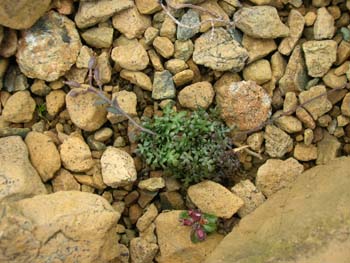 My PhD uses a model plant species to investigate how plants adapt to their local environment, and how this might influence the response of plants to future environmental changes. Essentially it is using modern techniques to explore just how evolution takes place.
My PhD uses a model plant species to investigate how plants adapt to their local environment, and how this might influence the response of plants to future environmental changes. Essentially it is using modern techniques to explore just how evolution takes place.
Northern rock-cress (Arabidopsis lyrata ssp. petraea, also known as Arabis petraea) has a scattered distribution across Scotland, generally confined to mountain scree, rock crags and river shingle. Part of this species' niche (the range of environmental conditions under which it can survive) is on serpentine soils.
Serpentine soils present difficult conditions for plant growth due to low levels of mineral nutrients, unfavourably high levels of Magnesium relative to Calcium, high levels of heavy metals, and low water availability. Together these have been considered the “serpentine syndrome”. Such conditions can act as a strong driving force for evolution, driving plants to develop different strategies best suited to their local environmental and soil conditions. In addition, as these serpentine soils are patchy in occurrence, opportunities for population mixing (and thus gene flow) are scarce and this could, over the long term, promote local evolution and the creation of new, localised species.
Using a controlled lab experiment I am examining whether plants collected from both serpentine and non-serpentine soils are better adapted to the soil type on which they originally developed. This aspect of my work addresses key questions, specifically: are there local adaptations to serpentine soil, what aspect of the ‘syndrome’ are plants adapted to, and has adaptation developed despite gene flow from plants outside of serpentine areas? Molecular DNA markers will be used to determine the genetic connectivity of these populations and to identify regions of the genome that may be candidate genes under natural selection.
Studying local adaptation to these serpentine soils provides important information on how species can adapt to their local environmental conditions. This information will also be used to inform our understanding of the potential response of plant populations to future environmental change. For this part of my research, I am working with Katja Schiffers (Aberdeen University) and Justin Travis (Aberdeen University) to develop a computer model that will assess how local adaptation affects the potential of plants to adapt to other environmental ‘stimuli’, such as climate change.
Liz Bourne, PhD Student
|
Updated: 23 Jan 2024, Content by: CN
|



